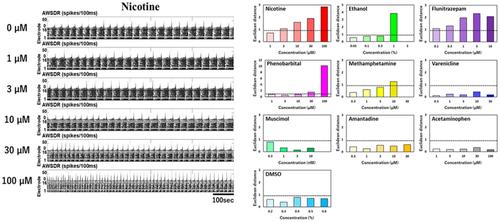当前位置:
X-MOL 学术
›
Strateg. Entrep. J.
›
论文详情
Our official English website, www.x-mol.net, welcomes your
feedback! (Note: you will need to create a separate account there.)
Development of an evaluation method for addictive compounds based on electrical activity of human iPS cell-derived dopaminergic neurons using microelectrode array
Strategic Entrepreneurship Journal ( IF 5.4 ) Pub Date : 2024-10-09 , DOI: 10.1111/adb.13443 Yuto Ishibashi, Nami Nagafuku, Shingo Kimura, Xiaobo Han, Ikuro Suzuki
Strategic Entrepreneurship Journal ( IF 5.4 ) Pub Date : 2024-10-09 , DOI: 10.1111/adb.13443 Yuto Ishibashi, Nami Nagafuku, Shingo Kimura, Xiaobo Han, Ikuro Suzuki

|
Addiction is known to occur through the consumption of substances such as pharmaceuticals, illicit drugs, food, alcohol and tobacco. These addictions can be viewed as drug addiction, resulting from the ingestion of chemical substances contained in them. Multiple neural networks, including the reward system, anti-reward/stress system and central immune system in the brain, are believed to be involved in the onset of drug addiction. Although various compound evaluations using microelectrode array (MEA) as an in vitro testing methods to evaluate neural activities have been conducted, methods for assessing addiction have not been established. In this study, we aimed to develop an in vitro method for assessing the addiction of compounds, as an alternative to animal experiments, using human iPS cell-derived dopaminergic neurons with MEA measurements. MEA data before and after chronic exposure revealed specific changes in addictive compounds compared to non-addictive compounds, demonstrating the ability to estimate addiction of compound. Additionally, conducting gene expression analysis on cultured samples after the tests revealed changes in the expression levels of various receptors (nicotine, dopamine and GABA) due to chronic administration of addictive compounds, suggesting the potential interpretation of these expression changes as addiction-like responses in MEA measurements. The addiction assessment method using MEA measurements in human iPS cell-derived dopaminergic neurons conducted in this study proves effective in evaluating addiction of compounds on human neural networks.
中文翻译:

使用微电极阵列开发基于人 iPS 细胞衍生的多巴胺能神经元电活性的成瘾化合物评价方法
众所周知,成瘾是通过消费药物、非法药物、食物、酒精和烟草等物质发生的。这些成瘾可以被视为药物成瘾,是由于摄入其中所含的化学物质而引起的。多种神经网络,包括大脑中的奖励系统、抗奖励/压力系统和中枢免疫系统,被认为与药物成瘾的发生有关。尽管已经使用微电极阵列 (MEA) 作为体外测试方法来评估神经活动,但尚未建立评估成瘾的方法。在这项研究中,我们旨在开发一种体外方法来评估化合物的成瘾性,作为动物实验的替代方案,使用人 iPS 细胞衍生的多巴胺能神经元进行 MEA 测量。慢性暴露前后的 MEA 数据揭示了与非成瘾化合物相比,成瘾化合物的特定变化,证明了估计化合物成瘾的能力。此外,在测试后对培养样品进行基因表达分析显示,由于长期服用成瘾化合物,各种受体(尼古丁、多巴胺和 GABA)的表达水平发生了变化,这表明这些表达变化可能被解释为 MEA 测量中的成瘾样反应。本研究中使用的人类 iPS 细胞衍生多巴胺能神经元中 MEA 测量的成瘾评估方法被证明可以有效地评估人类神经网络上化合物的成瘾性。
更新日期:2024-10-09
中文翻译:

使用微电极阵列开发基于人 iPS 细胞衍生的多巴胺能神经元电活性的成瘾化合物评价方法
众所周知,成瘾是通过消费药物、非法药物、食物、酒精和烟草等物质发生的。这些成瘾可以被视为药物成瘾,是由于摄入其中所含的化学物质而引起的。多种神经网络,包括大脑中的奖励系统、抗奖励/压力系统和中枢免疫系统,被认为与药物成瘾的发生有关。尽管已经使用微电极阵列 (MEA) 作为体外测试方法来评估神经活动,但尚未建立评估成瘾的方法。在这项研究中,我们旨在开发一种体外方法来评估化合物的成瘾性,作为动物实验的替代方案,使用人 iPS 细胞衍生的多巴胺能神经元进行 MEA 测量。慢性暴露前后的 MEA 数据揭示了与非成瘾化合物相比,成瘾化合物的特定变化,证明了估计化合物成瘾的能力。此外,在测试后对培养样品进行基因表达分析显示,由于长期服用成瘾化合物,各种受体(尼古丁、多巴胺和 GABA)的表达水平发生了变化,这表明这些表达变化可能被解释为 MEA 测量中的成瘾样反应。本研究中使用的人类 iPS 细胞衍生多巴胺能神经元中 MEA 测量的成瘾评估方法被证明可以有效地评估人类神经网络上化合物的成瘾性。































 京公网安备 11010802027423号
京公网安备 11010802027423号